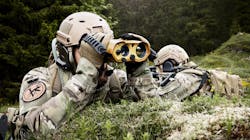Military researchers ask industry to develop a wearable laser detector to provide real-time warning
ARLINGTON, Va. – U.S. military researchers are asking industry to develop a small, lightweight, wearable laser detector to determine in real time if an adversary is using lasers for weapons guidance or range finding, or that could damage sensors or human eyes.
Officials of the U.S. Defense Advanced Research Projects Agency (DARPA) in Arlington, Va., issued a small-business innovation research (SBIR) solicitation (HR001120S0019-05) for the Wearable Laser Detection and Alert System.
DARPA researchers want to understand the feasibility of a wearable laser sensor that can detect laser irradiation rapidly during the day and at night and alert the wearer in real-time of lasing.
DARPA wants a wearable laser-detection system with low size, weight, and power consumption (SWaP) that would act as a stand-alone sensor to detect laser illumination over the 450-to-1600-nanometer visible to shortwave infrared region.
The wearable detection system should weigh no more than 3.53 ounces, and receive power from a rechargeable conformal wearable battery that weighs less than 3.3 pounds. This battery should be able to power laser detector for 72-hours of continuous operations.
The wearable system must provide real-time warning of lasing, be comfortable to wear, and be easily integrated into existing military head gear. Technology developed will fall under guidelines of the International Traffic in Arms Regulation (ITAR).
The system should be able to detect laser irradiation at energies of 500 microwatts per square centimeter and greater to warn personnel of potential ocular damage or damage to electro-optical and infrared sensors in near-real time.
Although DARPA researchers are interested in broadband coverage, they particularly are interested in wavelengths that include 532, 632, 1064, 1300, and 1550 nanometers.
Related: Probing what the human eye cannot see
The system should not react to bright non-laser sources such as solar phenomenon, flares, background light, thermal light, headlights, rocket plumes, muzzle flashes, and other sudden bursts of high-intensity light not related to laser illumination.
Proposers should provide a feasibility study for developing a laser detection system, including modeling and simulation. Proposals should identify commercial off-the-shelf (COTS) sensors or components that can help demonstrate the system.
Companies interested should upload proposals to the DOD SBIR/STTR Proposal Submission website at https://www.dodsbirsttr.mil/submissions/login no later than 26 May 2020.
Email questions or concerns to DARPA at [email protected]. More information is online at https://beta.sam.gov/opp/f35da0a4ad204bea99b80498b6d2f9a7/view.

